Comparative Analysis of CSP and PV Technologies for Sustainable Power
VerifiedAdded on 2023/03/17
|12
|2348
|35
Report
AI Summary
This report provides a comprehensive review of solar power technologies, focusing on their application in sustainable electricity generation. It begins with an overview of the background, emphasizing the need for renewable energy sources due to the depletion of fossil fuels and the emission of carbon dioxide. The study's objectives include reviewing the efficiencies and performance of solar power technologies and comparing Concentrated Solar Power (CSP) and Photovoltaic (PV) technologies based on sustainability indicators. A detailed literature review covers the increasing energy crisis, the importance of renewable energy, and the benefits of solar power systems in both rural and urban areas. The methodology involves a literature search, review of CSP and PV technologies, and a comparison based on sustainability indicators. Data analysis includes both primary and secondary sources, such as industry professionals' interviews and data from solar PV firms. The findings highlight the increasing adaptability of PV and CSP systems. The report concludes with a discussion on the environmental impacts, economic issues, and efficiency of solar power technologies, offering insights into the future of sustainable energy. The report includes figures, tables and questionnaires.

Academic and Research
Writing Skills
Student’s Name:
Student’s ID:
Subject:
Writing Skills
Student’s Name:
Student’s ID:
Subject:
Paraphrase This Document
Need a fresh take? Get an instant paraphrase of this document with our AI Paraphraser

1
Table of Contents
1. Background to the study..........................................................................................................................2
2. The objective of the study.......................................................................................................................2
3. Literature Review....................................................................................................................................2
4. Methodology...........................................................................................................................................4
5. Data analysis............................................................................................................................................4
6. Findings...................................................................................................................................................5
7. Conclusion...............................................................................................................................................5
References...................................................................................................................................................6
Appendices..................................................................................................................................................7
Table of Contents
1. Background to the study..........................................................................................................................2
2. The objective of the study.......................................................................................................................2
3. Literature Review....................................................................................................................................2
4. Methodology...........................................................................................................................................4
5. Data analysis............................................................................................................................................4
6. Findings...................................................................................................................................................5
7. Conclusion...............................................................................................................................................5
References...................................................................................................................................................6
Appendices..................................................................................................................................................7
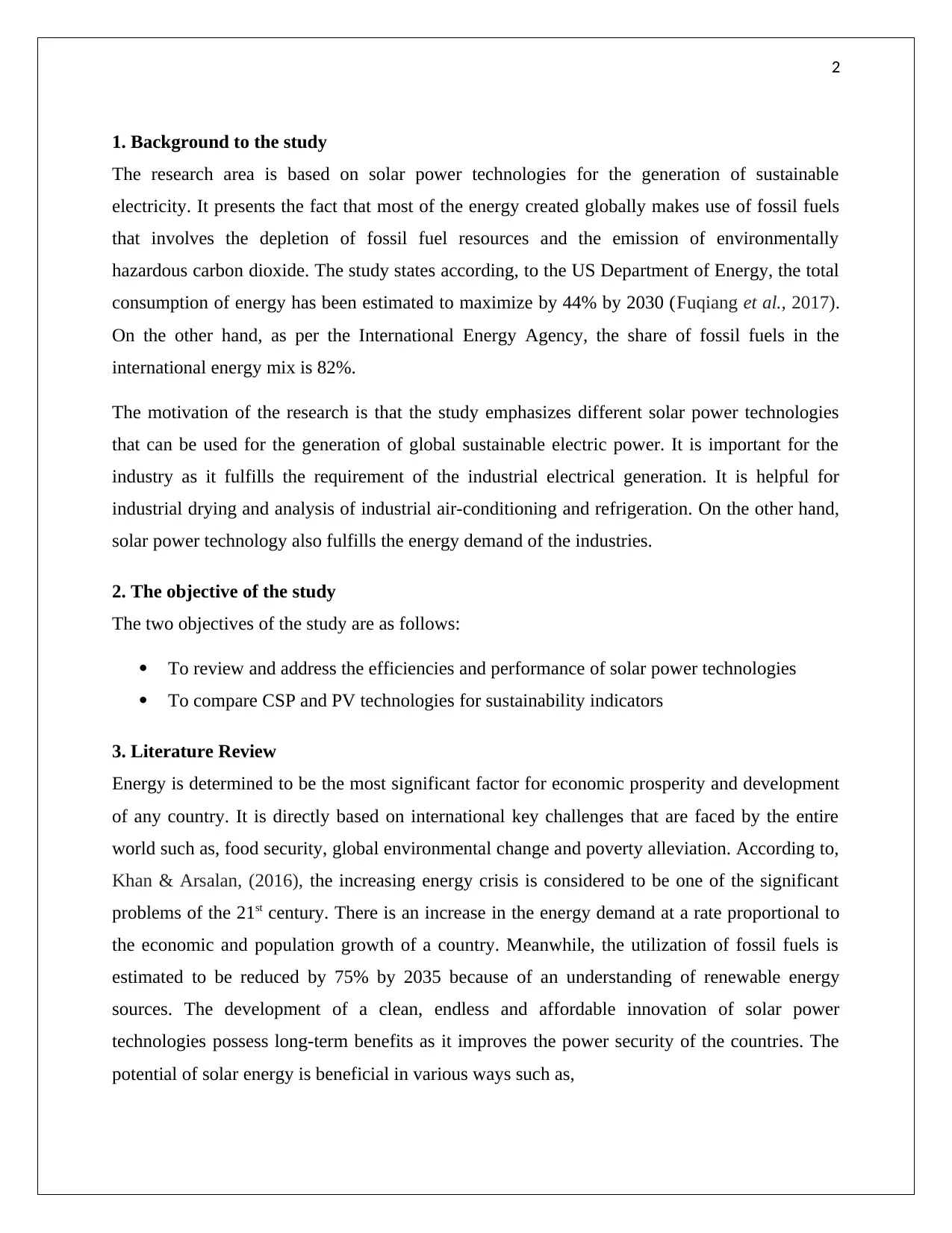
2
1. Background to the study
The research area is based on solar power technologies for the generation of sustainable
electricity. It presents the fact that most of the energy created globally makes use of fossil fuels
that involves the depletion of fossil fuel resources and the emission of environmentally
hazardous carbon dioxide. The study states according, to the US Department of Energy, the total
consumption of energy has been estimated to maximize by 44% by 2030 (Fuqiang et al., 2017).
On the other hand, as per the International Energy Agency, the share of fossil fuels in the
international energy mix is 82%.
The motivation of the research is that the study emphasizes different solar power technologies
that can be used for the generation of global sustainable electric power. It is important for the
industry as it fulfills the requirement of the industrial electrical generation. It is helpful for
industrial drying and analysis of industrial air-conditioning and refrigeration. On the other hand,
solar power technology also fulfills the energy demand of the industries.
2. The objective of the study
The two objectives of the study are as follows:
To review and address the efficiencies and performance of solar power technologies
To compare CSP and PV technologies for sustainability indicators
3. Literature Review
Energy is determined to be the most significant factor for economic prosperity and development
of any country. It is directly based on international key challenges that are faced by the entire
world such as, food security, global environmental change and poverty alleviation. According to,
Khan & Arsalan, (2016), the increasing energy crisis is considered to be one of the significant
problems of the 21st century. There is an increase in the energy demand at a rate proportional to
the economic and population growth of a country. Meanwhile, the utilization of fossil fuels is
estimated to be reduced by 75% by 2035 because of an understanding of renewable energy
sources. The development of a clean, endless and affordable innovation of solar power
technologies possess long-term benefits as it improves the power security of the countries. The
potential of solar energy is beneficial in various ways such as,
1. Background to the study
The research area is based on solar power technologies for the generation of sustainable
electricity. It presents the fact that most of the energy created globally makes use of fossil fuels
that involves the depletion of fossil fuel resources and the emission of environmentally
hazardous carbon dioxide. The study states according, to the US Department of Energy, the total
consumption of energy has been estimated to maximize by 44% by 2030 (Fuqiang et al., 2017).
On the other hand, as per the International Energy Agency, the share of fossil fuels in the
international energy mix is 82%.
The motivation of the research is that the study emphasizes different solar power technologies
that can be used for the generation of global sustainable electric power. It is important for the
industry as it fulfills the requirement of the industrial electrical generation. It is helpful for
industrial drying and analysis of industrial air-conditioning and refrigeration. On the other hand,
solar power technology also fulfills the energy demand of the industries.
2. The objective of the study
The two objectives of the study are as follows:
To review and address the efficiencies and performance of solar power technologies
To compare CSP and PV technologies for sustainability indicators
3. Literature Review
Energy is determined to be the most significant factor for economic prosperity and development
of any country. It is directly based on international key challenges that are faced by the entire
world such as, food security, global environmental change and poverty alleviation. According to,
Khan & Arsalan, (2016), the increasing energy crisis is considered to be one of the significant
problems of the 21st century. There is an increase in the energy demand at a rate proportional to
the economic and population growth of a country. Meanwhile, the utilization of fossil fuels is
estimated to be reduced by 75% by 2035 because of an understanding of renewable energy
sources. The development of a clean, endless and affordable innovation of solar power
technologies possess long-term benefits as it improves the power security of the countries. The
potential of solar energy is beneficial in various ways such as,
⊘ This is a preview!⊘
Do you want full access?
Subscribe today to unlock all pages.

Trusted by 1+ million students worldwide

3
Paraphrase This Document
Need a fresh take? Get an instant paraphrase of this document with our AI Paraphraser

4
Solar power systems are reasonable and relevant for both rural and urban areas
Solar power is environmentally friendly, and it is socially accepted because of its efficient
performance and reliability
The tropical and sub-tropical regions possess huge potential to harness the solar energy for
their electricity needs as these regions receive an increased amount of solar radiation
Comparison of PV and CSP technology
System efficiency
As compared to PV modules the CSP technology needs increased annual production of
electricity in terms of less output power. In the words of Prieto, Cooper, Fernández & Cabeza,
(2016), the solar PV installations have proved to be a more efficient system than CSP technology
because of its small land use needs. On the other hand, PV technology executes better
performance for both land use capability and electricity production. The annual production of
electricity is higher than PV technology where the conversion efficiencies of commercially
available PV systems are estimated to be 14-22%.
System sustainability
The significant relationship between sustainable development and global environmental
degradation is determined to be the major aspect. The carbon dioxide released from the burning
of fossil fuels is considered to be the largest source of greenhouse gas emissions (Stein & Buck,
2017). Moreover, the social acceptance, cost-effectiveness and environmental friendliness of the
implemented solar power technology are of great importance.
Environmental impacts
The long-term sustainability of solar power systems is determined by environmental impacts. As
per, Corona, Cerrajero, López & San Miguel, (2016), the significant issues of the solar power
plants are related to their decommissioning and assembling phase. At the time of the assembly
phase, the solar power systems create a higher influence on the environment than the CSP plants.
As per National Renewable Energy Laboratory, the harmonized median life cycle of greenhouse
gas emissions of the Trough and Tower based CSP systems differ from 22 to 23g CO2 eq/kWh.
Solar power systems are reasonable and relevant for both rural and urban areas
Solar power is environmentally friendly, and it is socially accepted because of its efficient
performance and reliability
The tropical and sub-tropical regions possess huge potential to harness the solar energy for
their electricity needs as these regions receive an increased amount of solar radiation
Comparison of PV and CSP technology
System efficiency
As compared to PV modules the CSP technology needs increased annual production of
electricity in terms of less output power. In the words of Prieto, Cooper, Fernández & Cabeza,
(2016), the solar PV installations have proved to be a more efficient system than CSP technology
because of its small land use needs. On the other hand, PV technology executes better
performance for both land use capability and electricity production. The annual production of
electricity is higher than PV technology where the conversion efficiencies of commercially
available PV systems are estimated to be 14-22%.
System sustainability
The significant relationship between sustainable development and global environmental
degradation is determined to be the major aspect. The carbon dioxide released from the burning
of fossil fuels is considered to be the largest source of greenhouse gas emissions (Stein & Buck,
2017). Moreover, the social acceptance, cost-effectiveness and environmental friendliness of the
implemented solar power technology are of great importance.
Environmental impacts
The long-term sustainability of solar power systems is determined by environmental impacts. As
per, Corona, Cerrajero, López & San Miguel, (2016), the significant issues of the solar power
plants are related to their decommissioning and assembling phase. At the time of the assembly
phase, the solar power systems create a higher influence on the environment than the CSP plants.
As per National Renewable Energy Laboratory, the harmonized median life cycle of greenhouse
gas emissions of the Trough and Tower based CSP systems differ from 22 to 23g CO2 eq/kWh.
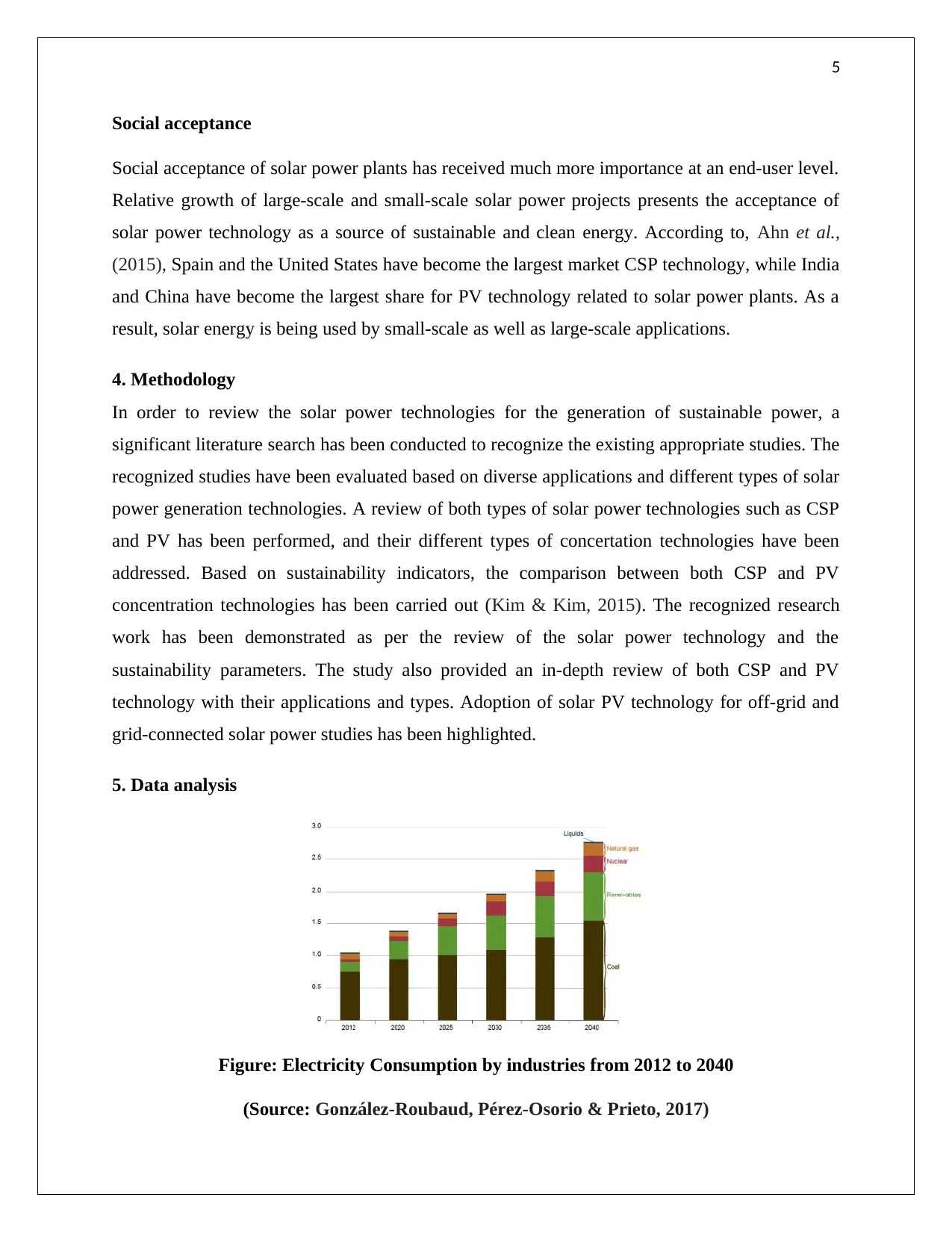
5
Social acceptance
Social acceptance of solar power plants has received much more importance at an end-user level.
Relative growth of large-scale and small-scale solar power projects presents the acceptance of
solar power technology as a source of sustainable and clean energy. According to, Ahn et al.,
(2015), Spain and the United States have become the largest market CSP technology, while India
and China have become the largest share for PV technology related to solar power plants. As a
result, solar energy is being used by small-scale as well as large-scale applications.
4. Methodology
In order to review the solar power technologies for the generation of sustainable power, a
significant literature search has been conducted to recognize the existing appropriate studies. The
recognized studies have been evaluated based on diverse applications and different types of solar
power generation technologies. A review of both types of solar power technologies such as CSP
and PV has been performed, and their different types of concertation technologies have been
addressed. Based on sustainability indicators, the comparison between both CSP and PV
concentration technologies has been carried out (Kim & Kim, 2015). The recognized research
work has been demonstrated as per the review of the solar power technology and the
sustainability parameters. The study also provided an in-depth review of both CSP and PV
technology with their applications and types. Adoption of solar PV technology for off-grid and
grid-connected solar power studies has been highlighted.
5. Data analysis
Figure: Electricity Consumption by industries from 2012 to 2040
(Source: González-Roubaud, Pérez-Osorio & Prieto, 2017)
Social acceptance
Social acceptance of solar power plants has received much more importance at an end-user level.
Relative growth of large-scale and small-scale solar power projects presents the acceptance of
solar power technology as a source of sustainable and clean energy. According to, Ahn et al.,
(2015), Spain and the United States have become the largest market CSP technology, while India
and China have become the largest share for PV technology related to solar power plants. As a
result, solar energy is being used by small-scale as well as large-scale applications.
4. Methodology
In order to review the solar power technologies for the generation of sustainable power, a
significant literature search has been conducted to recognize the existing appropriate studies. The
recognized studies have been evaluated based on diverse applications and different types of solar
power generation technologies. A review of both types of solar power technologies such as CSP
and PV has been performed, and their different types of concertation technologies have been
addressed. Based on sustainability indicators, the comparison between both CSP and PV
concentration technologies has been carried out (Kim & Kim, 2015). The recognized research
work has been demonstrated as per the review of the solar power technology and the
sustainability parameters. The study also provided an in-depth review of both CSP and PV
technology with their applications and types. Adoption of solar PV technology for off-grid and
grid-connected solar power studies has been highlighted.
5. Data analysis
Figure: Electricity Consumption by industries from 2012 to 2040
(Source: González-Roubaud, Pérez-Osorio & Prieto, 2017)
⊘ This is a preview!⊘
Do you want full access?
Subscribe today to unlock all pages.

Trusted by 1+ million students worldwide
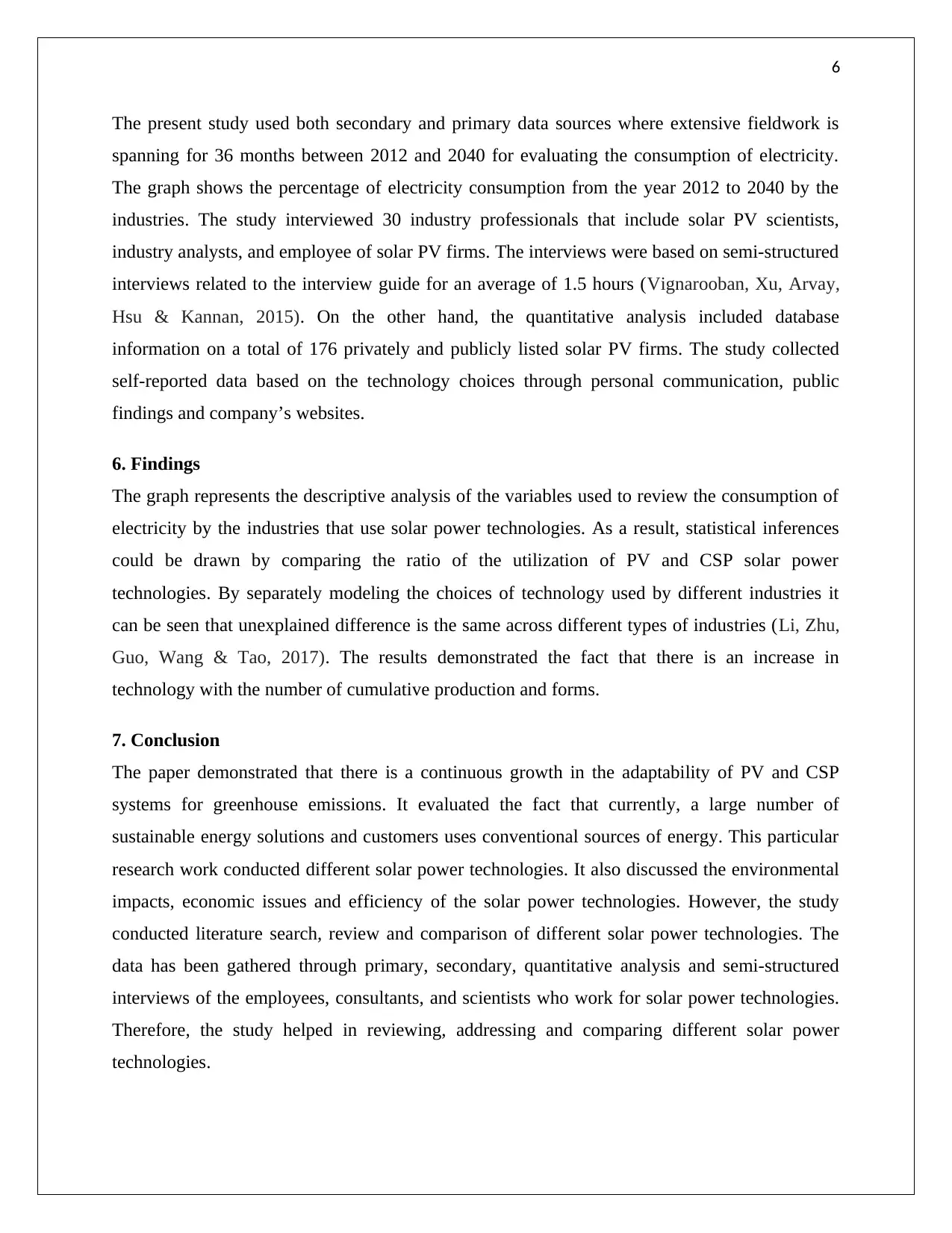
6
The present study used both secondary and primary data sources where extensive fieldwork is
spanning for 36 months between 2012 and 2040 for evaluating the consumption of electricity.
The graph shows the percentage of electricity consumption from the year 2012 to 2040 by the
industries. The study interviewed 30 industry professionals that include solar PV scientists,
industry analysts, and employee of solar PV firms. The interviews were based on semi-structured
interviews related to the interview guide for an average of 1.5 hours (Vignarooban, Xu, Arvay,
Hsu & Kannan, 2015). On the other hand, the quantitative analysis included database
information on a total of 176 privately and publicly listed solar PV firms. The study collected
self-reported data based on the technology choices through personal communication, public
findings and company’s websites.
6. Findings
The graph represents the descriptive analysis of the variables used to review the consumption of
electricity by the industries that use solar power technologies. As a result, statistical inferences
could be drawn by comparing the ratio of the utilization of PV and CSP solar power
technologies. By separately modeling the choices of technology used by different industries it
can be seen that unexplained difference is the same across different types of industries (Li, Zhu,
Guo, Wang & Tao, 2017). The results demonstrated the fact that there is an increase in
technology with the number of cumulative production and forms.
7. Conclusion
The paper demonstrated that there is a continuous growth in the adaptability of PV and CSP
systems for greenhouse emissions. It evaluated the fact that currently, a large number of
sustainable energy solutions and customers uses conventional sources of energy. This particular
research work conducted different solar power technologies. It also discussed the environmental
impacts, economic issues and efficiency of the solar power technologies. However, the study
conducted literature search, review and comparison of different solar power technologies. The
data has been gathered through primary, secondary, quantitative analysis and semi-structured
interviews of the employees, consultants, and scientists who work for solar power technologies.
Therefore, the study helped in reviewing, addressing and comparing different solar power
technologies.
The present study used both secondary and primary data sources where extensive fieldwork is
spanning for 36 months between 2012 and 2040 for evaluating the consumption of electricity.
The graph shows the percentage of electricity consumption from the year 2012 to 2040 by the
industries. The study interviewed 30 industry professionals that include solar PV scientists,
industry analysts, and employee of solar PV firms. The interviews were based on semi-structured
interviews related to the interview guide for an average of 1.5 hours (Vignarooban, Xu, Arvay,
Hsu & Kannan, 2015). On the other hand, the quantitative analysis included database
information on a total of 176 privately and publicly listed solar PV firms. The study collected
self-reported data based on the technology choices through personal communication, public
findings and company’s websites.
6. Findings
The graph represents the descriptive analysis of the variables used to review the consumption of
electricity by the industries that use solar power technologies. As a result, statistical inferences
could be drawn by comparing the ratio of the utilization of PV and CSP solar power
technologies. By separately modeling the choices of technology used by different industries it
can be seen that unexplained difference is the same across different types of industries (Li, Zhu,
Guo, Wang & Tao, 2017). The results demonstrated the fact that there is an increase in
technology with the number of cumulative production and forms.
7. Conclusion
The paper demonstrated that there is a continuous growth in the adaptability of PV and CSP
systems for greenhouse emissions. It evaluated the fact that currently, a large number of
sustainable energy solutions and customers uses conventional sources of energy. This particular
research work conducted different solar power technologies. It also discussed the environmental
impacts, economic issues and efficiency of the solar power technologies. However, the study
conducted literature search, review and comparison of different solar power technologies. The
data has been gathered through primary, secondary, quantitative analysis and semi-structured
interviews of the employees, consultants, and scientists who work for solar power technologies.
Therefore, the study helped in reviewing, addressing and comparing different solar power
technologies.
Paraphrase This Document
Need a fresh take? Get an instant paraphrase of this document with our AI Paraphraser
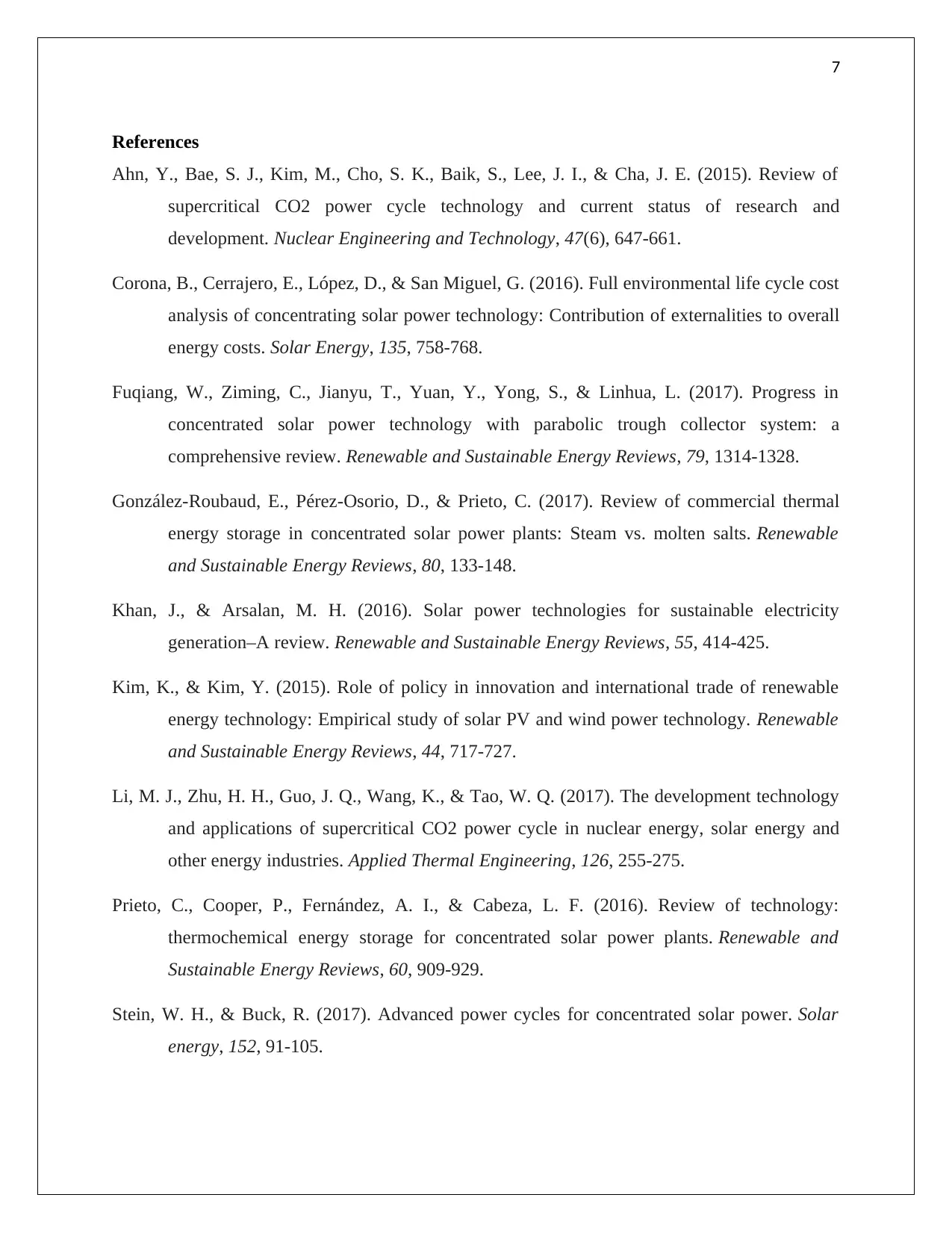
7
References
Ahn, Y., Bae, S. J., Kim, M., Cho, S. K., Baik, S., Lee, J. I., & Cha, J. E. (2015). Review of
supercritical CO2 power cycle technology and current status of research and
development. Nuclear Engineering and Technology, 47(6), 647-661.
Corona, B., Cerrajero, E., López, D., & San Miguel, G. (2016). Full environmental life cycle cost
analysis of concentrating solar power technology: Contribution of externalities to overall
energy costs. Solar Energy, 135, 758-768.
Fuqiang, W., Ziming, C., Jianyu, T., Yuan, Y., Yong, S., & Linhua, L. (2017). Progress in
concentrated solar power technology with parabolic trough collector system: a
comprehensive review. Renewable and Sustainable Energy Reviews, 79, 1314-1328.
González-Roubaud, E., Pérez-Osorio, D., & Prieto, C. (2017). Review of commercial thermal
energy storage in concentrated solar power plants: Steam vs. molten salts. Renewable
and Sustainable Energy Reviews, 80, 133-148.
Khan, J., & Arsalan, M. H. (2016). Solar power technologies for sustainable electricity
generation–A review. Renewable and Sustainable Energy Reviews, 55, 414-425.
Kim, K., & Kim, Y. (2015). Role of policy in innovation and international trade of renewable
energy technology: Empirical study of solar PV and wind power technology. Renewable
and Sustainable Energy Reviews, 44, 717-727.
Li, M. J., Zhu, H. H., Guo, J. Q., Wang, K., & Tao, W. Q. (2017). The development technology
and applications of supercritical CO2 power cycle in nuclear energy, solar energy and
other energy industries. Applied Thermal Engineering, 126, 255-275.
Prieto, C., Cooper, P., Fernández, A. I., & Cabeza, L. F. (2016). Review of technology:
thermochemical energy storage for concentrated solar power plants. Renewable and
Sustainable Energy Reviews, 60, 909-929.
Stein, W. H., & Buck, R. (2017). Advanced power cycles for concentrated solar power. Solar
energy, 152, 91-105.
References
Ahn, Y., Bae, S. J., Kim, M., Cho, S. K., Baik, S., Lee, J. I., & Cha, J. E. (2015). Review of
supercritical CO2 power cycle technology and current status of research and
development. Nuclear Engineering and Technology, 47(6), 647-661.
Corona, B., Cerrajero, E., López, D., & San Miguel, G. (2016). Full environmental life cycle cost
analysis of concentrating solar power technology: Contribution of externalities to overall
energy costs. Solar Energy, 135, 758-768.
Fuqiang, W., Ziming, C., Jianyu, T., Yuan, Y., Yong, S., & Linhua, L. (2017). Progress in
concentrated solar power technology with parabolic trough collector system: a
comprehensive review. Renewable and Sustainable Energy Reviews, 79, 1314-1328.
González-Roubaud, E., Pérez-Osorio, D., & Prieto, C. (2017). Review of commercial thermal
energy storage in concentrated solar power plants: Steam vs. molten salts. Renewable
and Sustainable Energy Reviews, 80, 133-148.
Khan, J., & Arsalan, M. H. (2016). Solar power technologies for sustainable electricity
generation–A review. Renewable and Sustainable Energy Reviews, 55, 414-425.
Kim, K., & Kim, Y. (2015). Role of policy in innovation and international trade of renewable
energy technology: Empirical study of solar PV and wind power technology. Renewable
and Sustainable Energy Reviews, 44, 717-727.
Li, M. J., Zhu, H. H., Guo, J. Q., Wang, K., & Tao, W. Q. (2017). The development technology
and applications of supercritical CO2 power cycle in nuclear energy, solar energy and
other energy industries. Applied Thermal Engineering, 126, 255-275.
Prieto, C., Cooper, P., Fernández, A. I., & Cabeza, L. F. (2016). Review of technology:
thermochemical energy storage for concentrated solar power plants. Renewable and
Sustainable Energy Reviews, 60, 909-929.
Stein, W. H., & Buck, R. (2017). Advanced power cycles for concentrated solar power. Solar
energy, 152, 91-105.
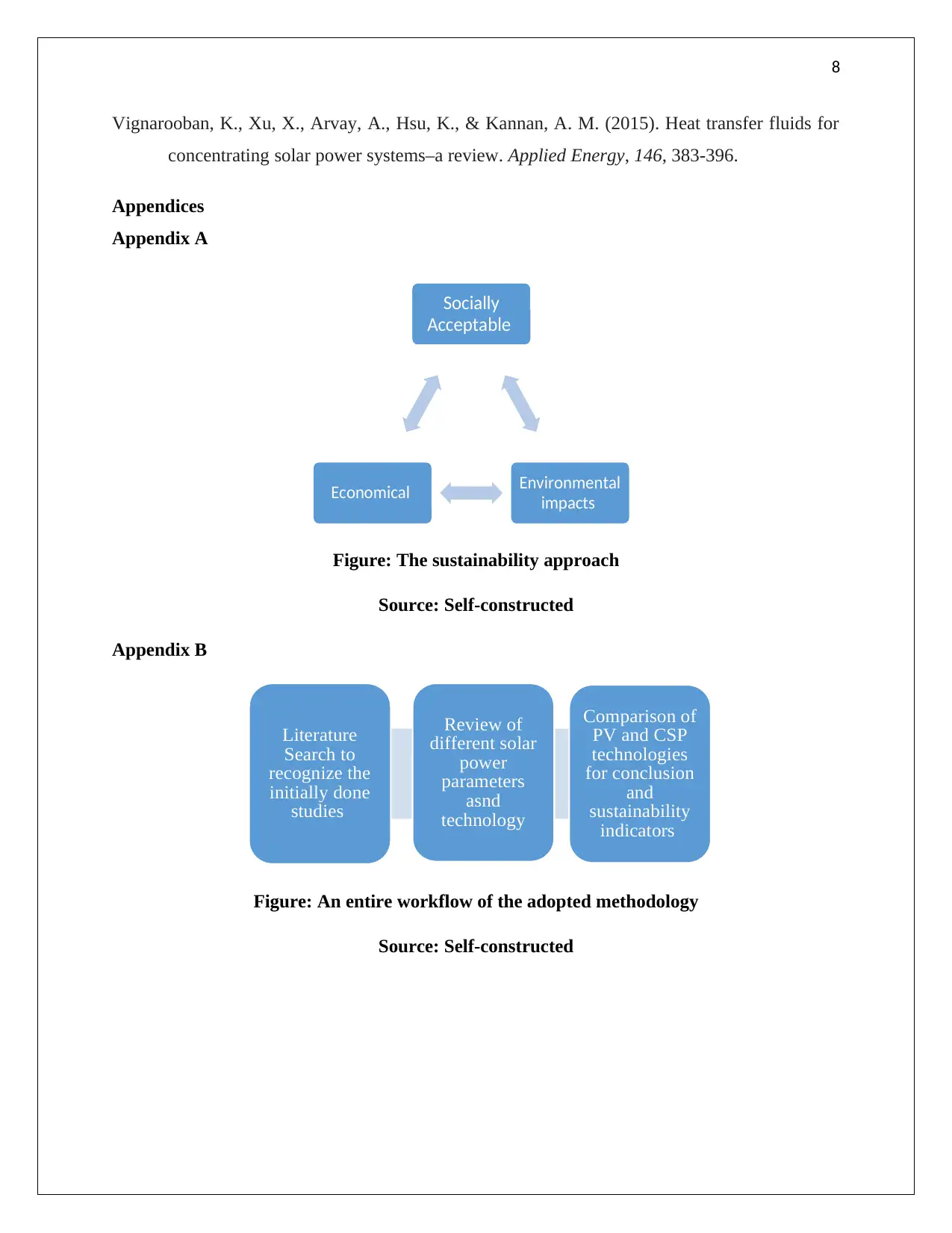
8
Vignarooban, K., Xu, X., Arvay, A., Hsu, K., & Kannan, A. M. (2015). Heat transfer fluids for
concentrating solar power systems–a review. Applied Energy, 146, 383-396.
Appendices
Appendix A
Figure: The sustainability approach
Source: Self-constructed
Appendix B
Figure: An entire workflow of the adopted methodology
Source: Self-constructed
Socially
Acceptable
Environmental
impacts
Economical
Literature
Search to
recognize the
initially done
studies
Review of
different solar
power
parameters
asnd
technology
Comparison of
PV and CSP
technologies
for conclusion
and
sustainability
indicators
Vignarooban, K., Xu, X., Arvay, A., Hsu, K., & Kannan, A. M. (2015). Heat transfer fluids for
concentrating solar power systems–a review. Applied Energy, 146, 383-396.
Appendices
Appendix A
Figure: The sustainability approach
Source: Self-constructed
Appendix B
Figure: An entire workflow of the adopted methodology
Source: Self-constructed
Socially
Acceptable
Environmental
impacts
Economical
Literature
Search to
recognize the
initially done
studies
Review of
different solar
power
parameters
asnd
technology
Comparison of
PV and CSP
technologies
for conclusion
and
sustainability
indicators
⊘ This is a preview!⊘
Do you want full access?
Subscribe today to unlock all pages.

Trusted by 1+ million students worldwide
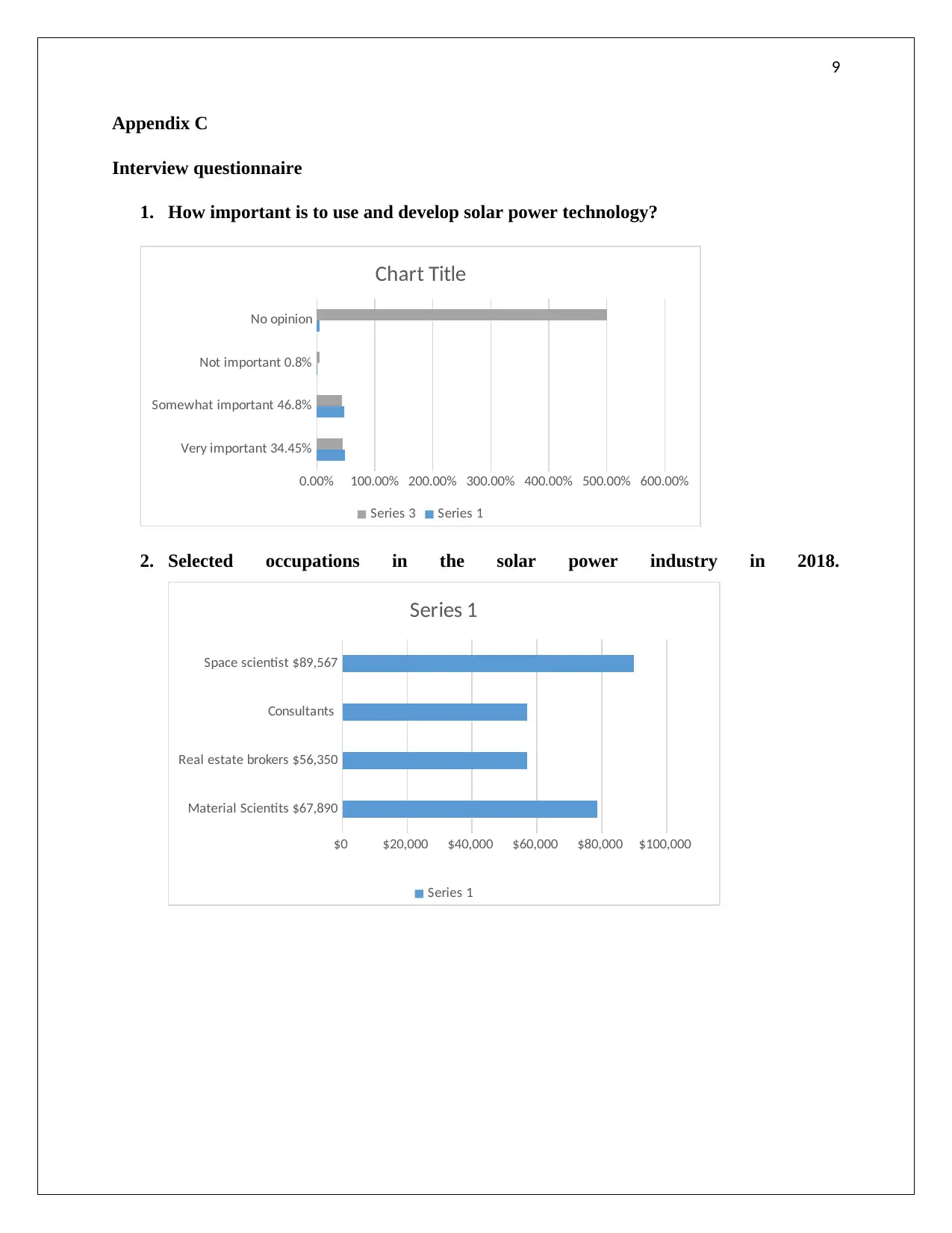
9
Appendix C
Interview questionnaire
1. How important is to use and develop solar power technology?
Very important 34.45%
Somewhat important 46.8%
Not important 0.8%
No opinion
0.00% 100.00% 200.00% 300.00% 400.00% 500.00% 600.00%
Chart Title
Series 3 Series 1
2. Selected occupations in the solar power industry in 2018.
Material Scientits $67,890
Real estate brokers $56,350
Consultants
Space scientist $89,567
$0 $20,000 $40,000 $60,000 $80,000 $100,000
Series 1
Series 1
Appendix C
Interview questionnaire
1. How important is to use and develop solar power technology?
Very important 34.45%
Somewhat important 46.8%
Not important 0.8%
No opinion
0.00% 100.00% 200.00% 300.00% 400.00% 500.00% 600.00%
Chart Title
Series 3 Series 1
2. Selected occupations in the solar power industry in 2018.
Material Scientits $67,890
Real estate brokers $56,350
Consultants
Space scientist $89,567
$0 $20,000 $40,000 $60,000 $80,000 $100,000
Series 1
Series 1
Paraphrase This Document
Need a fresh take? Get an instant paraphrase of this document with our AI Paraphraser

10
3. Strong support of the public for expanding solar power.
Solar panel farms 90
Offshore drilling 45
Coal mining
Nyclear power plants
43
0 10 20 30 40 50 60 70 80 90 100
Series 1
Series 1
4. How likely will people be willing to pay for solar power technology?
Highly unlikely 17.2%
Somewhat likely 76.45%
Somewhat likely 76.45%
Highly likely 17.2%
0.00%
10.00%
20.00%
30.00%
40.00%
50.00%
60.00%
70.00%
80.00%
90.00%
100.00%
Chart Title
Series 2 Series 1
3. Strong support of the public for expanding solar power.
Solar panel farms 90
Offshore drilling 45
Coal mining
Nyclear power plants
43
0 10 20 30 40 50 60 70 80 90 100
Series 1
Series 1
4. How likely will people be willing to pay for solar power technology?
Highly unlikely 17.2%
Somewhat likely 76.45%
Somewhat likely 76.45%
Highly likely 17.2%
0.00%
10.00%
20.00%
30.00%
40.00%
50.00%
60.00%
70.00%
80.00%
90.00%
100.00%
Chart Title
Series 2 Series 1
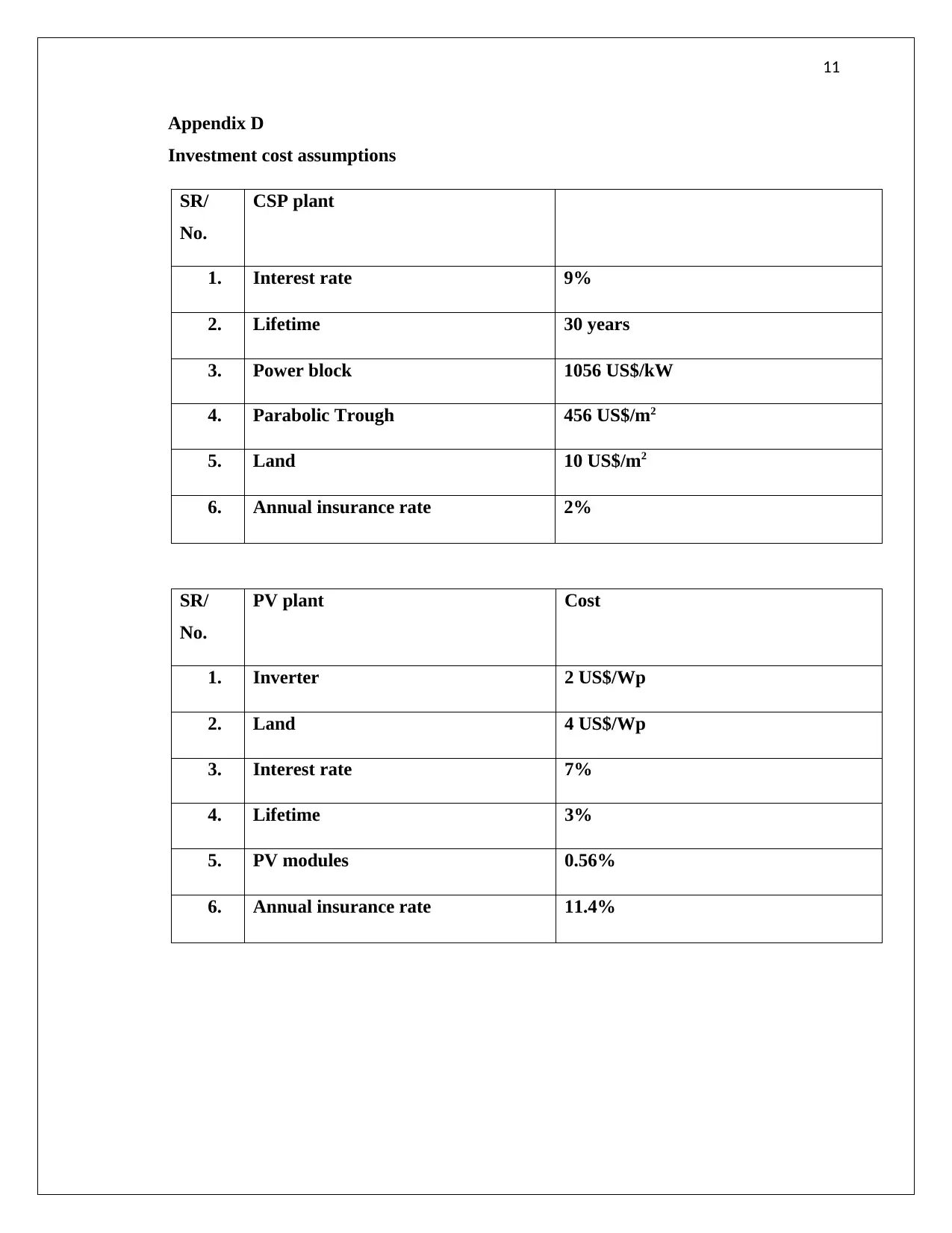
11
Appendix D
Investment cost assumptions
SR/
No.
CSP plant
1. Interest rate 9%
2. Lifetime 30 years
3. Power block 1056 US$/kW
4. Parabolic Trough 456 US$/m2
5. Land 10 US$/m2
6. Annual insurance rate 2%
SR/
No.
PV plant Cost
1. Inverter 2 US$/Wp
2. Land 4 US$/Wp
3. Interest rate 7%
4. Lifetime 3%
5. PV modules 0.56%
6. Annual insurance rate 11.4%
Appendix D
Investment cost assumptions
SR/
No.
CSP plant
1. Interest rate 9%
2. Lifetime 30 years
3. Power block 1056 US$/kW
4. Parabolic Trough 456 US$/m2
5. Land 10 US$/m2
6. Annual insurance rate 2%
SR/
No.
PV plant Cost
1. Inverter 2 US$/Wp
2. Land 4 US$/Wp
3. Interest rate 7%
4. Lifetime 3%
5. PV modules 0.56%
6. Annual insurance rate 11.4%
⊘ This is a preview!⊘
Do you want full access?
Subscribe today to unlock all pages.

Trusted by 1+ million students worldwide
1 out of 12